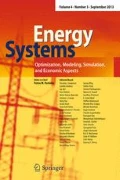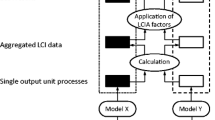Abstract
The robust least square method has been introduced in the literature as a new parameter estimation technique to deal with the presence of data uncertainties. In this paper we propose to use the robust least square method combined with log-linear Cobb–Douglas model as an alternative for developing forecast models. We first extend the robust least square method to the case which allows uncertainties only in some columns of the data matrix as well as to include weighting matrices on the past data observations and on the uncertainties. Afterwards we compare the robust and ordinary least square methods for the yearly estimate for the natural gas demand in Brazil, considering the total demand as well as the industrial and power sectors demand. Regarding the power sector case, a further contribution of the paper is to analyze the impact of the reservoirs’ levels over the demand of natural gas by thermoelectric power plants in an energy mix dominated by hydropower. Although both methods, the robust and the ordinary least square, presented similar results, the robust approach gave a slightly better result and presented reasonable long-run elasticities related to the demand of natural in the country, indicating that can it be a good alternative to overcome the difficulties associated with the use of short time series and unreliable data on the forecast of energy consumption in emerging markets.






Similar content being viewed by others
References
Adams, F.G., Shachmurove, Y.: Modeling and forecasting energy consumption in China: implications for Chinese energy demand and imports in 2020. Energy Econ. 30(3), 1263–1278 (2008)
Almeida, E.F., Colomer, M.F.: Industria do Gás Natural—Fundamentos Técnicos e Econômicos. Ed. Synergia, Rio de Janeiro, Brazil (2013)
ANP Agência Nacional de Petróleo, Gás e Biocombustíveis. Evolução da Industria Brasileira de Gás Natural: Aspectos Técnicos, Econômicos e Jurídicos. http://www.anp.gov.br/wwwanp/?dw=32427 (2009)
Barak, S., Sadegh, S.S.: Forecasting energy consumption using ensemble ARIMA–ANFIS hybrid algorithm. Int. J. Electr. Power Energy Syst. 82, 92–104 (2016)
Ben-Tal, A., El Ghaoui, L., Nemirovski, A.: Robust Optimization. Princeton University Press, Princeton (2009)
Cabral, R., Parente, V.: Demanda por gás natural no Brasil: um estudo sobre as elasticidades preço e renda de longo prazo do segmento industrial e estimativa para o período de 2008–2012, usando um modelo VEC. In: Proceedings of the Rio Oil and Gas Expo and Conference 2008, pp. 1–8, Rio de Janeiro, Brazil (2008)
Campos, A.F., da Silva, N.F., Pereira, M.G., Freitas, M.A.V.: A review of Brazilian natural gas industry: challenges and strategies. Renew. Sustain. Energy Rev. 75, 1207–1216 (2017)
Chandrasekaran, S., Golub, G., Gu, M., Sayed, A.: Parameter estimation in the presence of bounded data uncertainties. SIAM J. Matrix Anal. Appl. 19(1), 235–252 (1998)
Costa, O.L.V., Ribeiro, C.O., Rego, E.E., Stern, J.M., Parente, V., Kileber, S.: Robust portfolio optimization for electricity planning: an application based on the Brazilian electricity mix. Energy Econ. 64, 158–169 (2017)
Efron, B., Tibshirani, R.J.: An Introduction to the Bootstrap. CRC Press, London (1994)
El Ghaoui, L., Lebret, H.: Robust least squares and applications. In: Proceedings of 35th IEEE Conference on Decision and Control, vol. 1. Kobe, Japan, pp. 249–254
El Ghaoui, L., Lebret, H.: Robust solutions to least-squares problems with uncertain data. SIAM J. Matrix Anal. Appl. 18(4), 1035–1064 (1997)
El Ghaoui, L., Oks, M., Oustry, F.: Worst-case value-at-risk and robust portfolio optimization: a conic programming approach. Oper. Res. 51, 543–556 (2003)
Eldar, Y.C., Ben-Tal, A., Nemirovski, A.: Robust mean-squared error estimation in the presence of model uncertainties. IEEE Trans. Signal Process. 53(1), 168–181 (2005)
Empresa de Planejamento Energético-EPE. Plano Nacional de Energia 2050. http://www.epe.gov.br (2007)
Energy Initiative MIT EI Massachusetts Institute of Technology. The future of natural gas: an interdisciplinary MIT study. http://energy.mit.edu/research/future-natural-gas/ (2011)
Erdogdu, E.: Natural gas demand in Turkey. Appl. Energy 87(1), 211–219 (2010)
Fabozzi, F.J., Kolm, P.N., Pachamanova, D.A., Focardi, S.M.: Robust portfolio optimization. J. Portf. Manag. 33, 40–48 (2007a)
Fabozzi, F.J., Kolm, P.N., Pachamanova, D.A., Focardi, S.M.: Robust Portfolio Optimization and Management. Wiley Finance, Hoboken (2007b)
Ferraro, M.C., Hallack, M.: The development of the natural gas transportation network in Brazil: recent changes to the gas law and its role in co-ordinating new investments. Energy Policy 50, 601–612 (2012)
Gorucu, F.B.: Artificial neural network modeling for forecasting gas consumption. Energy Sour 26(3), 299–307 (2004)
Hong, W.-C.: Intelligent Energy Demand Forecasting. Springer, London (2013)
International Energy Agency-IEA. Statistics. http://www.iea.org/statistics (2017)
Işik, C.: Natural gas consumption and economic growth in Turkey: a bound test approach. Energy Syst. 1(4), 441–456 (2010)
Khan, M.A.: Modelling and forecasting the demand for natural gas in Pakistan. Renew. Sustain. Energy Rev. 49, 1145–1159 (2015)
Khashei, M., Bijari, M.: An artificial neural network (p, d, q) model for timeseries forecasting. Expert Syst. Appl. 37(1), 479–489 (2010)
Kim, J.H., Kim, W.C., Fabozzi, F.J.: Recent developments in robust portfolios with a worst-case approach. J Optim Theory Appl 161, 103–121 (2014)
Lobo, M.S., Vandenberghe, L., Boyd, S., Lebret, H.: Applications of second-order cone programming. Linear Algebra Appl. 284(1), 193–228 (1998)
Ministério de Minas e Energia (MME) and Empresa de Pesquisa Energética (EPE). Brazilian Energy Balance. http://www.epe.gov.br/en/publications/publications/brazilian-energy-balance/brazilian-energy-balance-2016 (2016)
Ministério de Minas e Energia (MME) and Empresa de Pesquisa Energética (EPE). Plano Decenal de Energia 2026. http://www.epe.gov.br/pt/publicacoes-dados-abertos/publicacoes/Plano-Decenal-de-Expansao-de-Energia-2026 (2017)
Ministério de Minas e Energia-MME. Boletim Mensal de Acompanhamento da Indústria de Gás Natural. http://www.mme.gov.br/web/guest/secretarias/petroleo-gas-natural-e-combustiveis-renovaveis/publicacoes/boletim-mensal-de-acompanhamento-da-industria-de-gas-natural (2016)
Moutinho dos Santos, E, Fagá, M.T.W., Barufi, C.B., Polallion, P.L.: Natural gas—the construction of a new civilization. Estudos Avançados 59(21), 67–90 (2007). https://www.revistas.usp.br/eav/article/view/10207/11805
Operador Nacional do Sistema Elétrico. ONS-Histórico da Operação. http://www.ons.org.br/paginas/resultados-da-operacao/historico-da-operacao (2018)
Rosa, L.P., Silva, N.F., Pereira, M.G., Losekann, L.D.: The evolution of Brazilian electricity market. In: Sioshansi, F.P. (ed.) Evolution of Global Electricity Markets: New paradigms. New Challenges, New Approaches. chapter 15, pp. 435–460. Elsevier, New York (2013)
Sayed, A.H., Nascimento, V.H., Chandrasekaran, S.: Estimation and control with bounded data uncertainties. Linear Algebra Appl 284(1), 259–306 (1998)
Soldo, B.: Forecasting natural gas consumption. Appl. Energy 92, 26–37 (2012)
Szoplik, J.: Forecasting of natural gas consumption with artificial neural networks. Energy 85, 208–220 (2015)
Vanli, N.D., Donmez, M.A., Kozat, S.S.: Robust least squares methods under bounded data uncertainties. Digital Signal Process. 36, 82–92 (2015)
Wadud, Z., Dey, H.S., Kabir, M.A., Khan, S.I.: Modeling and forecasting natural gas demand in Bangladesh. Energy Policy 39(11), 7372–7380 (2011)
Yi-Chung, H.: Electricity consumption prediction using a neural-network-based grey forecasting approach. J. Oper. Res. Soc. 68(10), 1259–1264 (2017)
Zhang, G.P.: Time series forecasting using a hybrid ARIMA and neural network model. Neurocomputing 50, 159–175 (2003)
Zhang, G.P., Qi, M.: Neural network forecasting for seasonal and trend time series. Eur. J. Oper. Res. 160(2), 501–514 (2005)
Author information
Authors and Affiliations
Corresponding author
Additional information
Publisher's Note
Springer Nature remains neutral with regard to jurisdictional claims in published maps and institutional affiliations.
Research supported in part by Project Fapesp/Shell Research Centre for Gas Innovation, Grant 2014/50279-4. The first, second, third and fourth authors received financial support from CNPq (Brazilian National Research Council), Grants 304091/2014-6, 307126/2018-8, 304670/2014-6 and 303865/2017-2 respectively.
Appendix
Appendix
1.1 Second-order cone programming (SOCP)
A SCOP is defined as follows:
where \(\mathbf c ,\mathbf e _i\in \mathbb {R}^n\), \(\mathbf A _i \in \mathbb {R}^{n_i\times n}\) and \(\mathbf d _i\in \mathbb {R}\). As pointed out in [28] SOCP includes several important standard classes of convex optimization problems, such as linear programming (LP), quadratic programming (QP) and quadratically constrained quadratic program (QCQP). Several very efficient primal-dual interior-point methods for SOCP have been developed in the last few years, which makes this class of problem very attractive from the numerical point of view.
1.2 Proof of Theorem 1
The goal of this subsection is to show (5), following the same approach as in Theorem 3.1 in [12]. First we notice that
since \(\Vert \mathbf{W } [ \varDelta \mathbf A _2 \,\,\varDelta \mathbf b ] {\varvec{\varGamma }^{-1}} \Vert \le \rho \). Define now \(\begin{bmatrix} \varDelta \mathbf A _2^*&\varDelta \mathbf b ^* \end{bmatrix}\) as
where \(\mathbf v \) is defined, for the case in which \(\mathbf{Ax } \ne \mathbf b \), as
and for the case in which \(\mathbf{Ax } = \mathbf b \), as \(\mathbf v = \mathbf e \) where \(\mathbf e \) is a vector such that \(\Vert \mathbf{W }{} \mathbf e \Vert =1\). From (18) we have that
since \(\Vert \mathbf{W }{} \mathbf v \Vert =1\). Moreover, for the case in which \(\mathbf{Ax } \ne \mathbf b \), we have from (18), (19) that
and similarly for the case in which \(\mathbf{Ax }=\mathbf b \) we have that
Rights and permissions
About this article
Cite this article
Costa, O.L.V., de Oliveira Ribeiro, C., Ho, L.L. et al. A robust least square approach for forecasting models: an application to Brazil’s natural gas demand. Energy Syst 11, 1111–1135 (2020). https://doi.org/10.1007/s12667-019-00351-1
Received:
Accepted:
Published:
Issue Date:
DOI: https://doi.org/10.1007/s12667-019-00351-1




